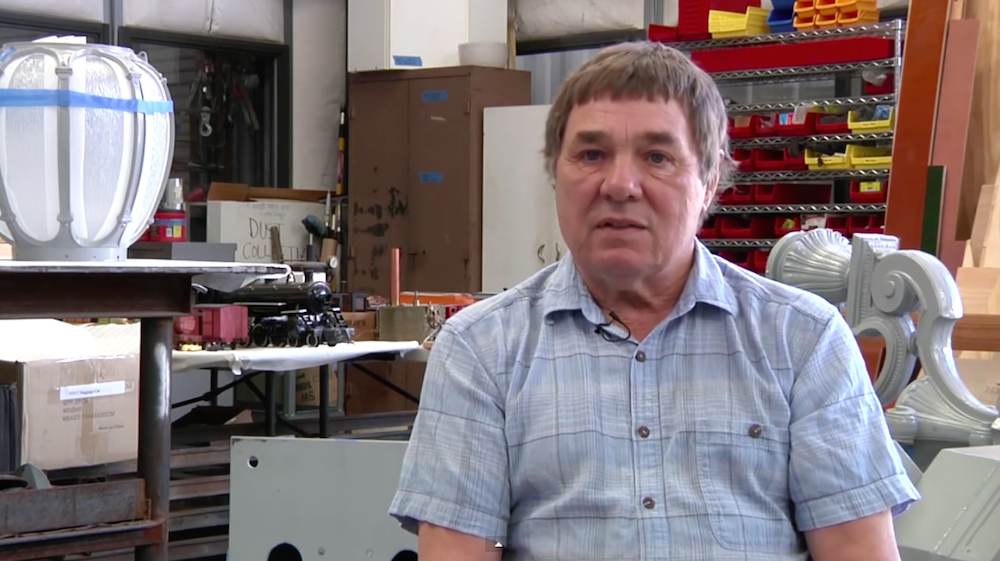I was shocked today by the sad news of Los Angeles performance artist, Chris Burden’s death. Both a controversial artist and a groundbreaking creator of art, antics and sculpture, Chris Burden was unlike any other artist I know. Here’s what Brian Boucher at Artnet News reported about him:
Performance artist and sculptor Chris Burden, who may remain best known for a performance in which he had himself shot in the arm, died today at his home in Topanga Canyon, California, at age 69. The cause was malignant melanoma, according to the artist’s friend Paul Schimmel, as reported in the L.A. Times.
Both Los Angeles and New York currently have sculptures by the artist on prominent display: Urban Light (2008), his assemblage of streetlamps, is on view outside the Los Angeles County Museum of Art (LACMA). In Manhattan, two works adorn the façade of the New Museum: Ghost Ship (2005), in the shape of a boat, and Twin Quasi Legal Skyscrapers (2013), in the form of twin towers. The latter works addressed current events such as Hurricane Sandy and the 9/11 terrorist attacks, and remain on view since a 2013-14 retrospective there.
“Chris was an artistic giant, a mentor to so many, an influential teacher, a maverick who played by his own rules, a fearless risk taker, endlessly curious and also rigorous and exacting,” New Museum director Lisa Phillips told artnet News via email. “It was a great honor to work with him so closely over the past several years to realize his biggest museum exhibition, including a monumental installation on the New Museum facade that he hoped would alter the skyline of our neighborhood. It will remain on view for the next several months in tribute to Chris and his vision. Our thoughts go out to his wife and life partner, Nancy Rubins, as well as to Katy and the entire team at the studio, who were really an extended family.”

What My Dad Gave Me, 2008. SEONG KWON/PUBLIC ART FUND
“Few artists can claim a body of work as rich, varied, and influential as Chris Burden,” LACMA director Michael Govan told artnet News via email. “Personally, it has been a privilege and pleasure to work with Chris on the installation of two monumental works at the Los Angeles County Museum of Art, Urban Light and Metropolis II, two artworks that have become destinations for visitors of all backgrounds.
“Chris has left his mark not only on the art world but also on Los Angeles, his home since the late 1960s, thanks to Urban Light [above]. Installed at LACMA’s entrance and made from 202 historic LA street lamps, it stands as a testament to the lasting power of Chris Burden’s talent, skill, and imagination.”
Due to Burden’s willingness to endure physical suffering and even injury in his 1970s performances, those performances are still bracing. Burden had a friend shoot him in the arm (Shoot (1971)), had himself confined for nearly a week in a locker (Five Day Locker Piece (1971), his master’s project at the University of California Irvine), had himself shocked (Doorway to Heaven (1973)), and had himself crucified on the roof of a car (Trans-fixed (1974)). To create Through the Night Softly (1973), he crawled across broken glass.
The New Yorker magazine critic Peter Schjeldahl called Shoot both a classic and an atrocity. In response to the critic’s question as to why he created such works, Burden told Schjeldahl, “I wanted to be taken seriously as an artist.”
During the same period, he created ads for himself, which he had aired on local television, toying with the distinction between art and entertainment (4 TV Ads, 1973-77).
“It felt that TV was basically a one-way street,” the artist said in an interview for MOCA TV. “How could you get on TV? It finally dawned on me that the way you could get on TV was that you would buy the time, just like any other product. The programming is just fluff. The guts of TV was the ads.” He found it a great feeling, he said, to have millions of homes receiving his message via television.
When a producer pulled the video of him crawling over glass, volunteer lawyers intervened on his behalf. “It was a very powerful feeling to have the TV stations cowering when you call them up when you’ve only spent $900,” he says, laughing, in the interview. The ad rep who took that payment was fired, he said.
In 1972, visitors to Burden’s show at LA’s Mizuno Gallery saw what appeared to be a crime scene, with a body lying under a blanket on La Cienega Boulevard, surrounded by police flares. In fact, it was the artist himself “making a piece of sculpture,” as he later put it. He was arrested for creating a false emergency. The jury in the case failed to reach a decision after three days of deliberation, and ultimately the judge dismissed the case (see 7 Artists Who Were Arrested for Their Art).
In a 1975 interview, Burden defined art as “a free spot in society, where you can do anything.”
Since quitting performance in 1979, Burden worked as a sculptor notably creating giant bridge-shaped constructions with Meccano and Erector set parts. These works recalled childhood play taken to absurd extremes of scale.
In other works, Burden turned his attention to state power structures and oppressive authority. His sculpture L.A.P.D. Uniforms (1993), made in the wake of the 1992 LA riots following the acquittal of the police officers who beat taxi driver Rodney King, consisted of drastically oversized police uniforms. All the Submarines of the United States of America (1987), through hundreds of cardboard models, gave visual form to one aspect of America’s military infrastructure. And it should be noted that Shoot took place during the Vietnam era, after the Kent State shootings.
Another work of Burden’s took the form of a retort to Maya Lin’s Vietnam War Memorial, in Washington, D.C.: Burden had the names of three million Vietnamese who were killed in the war engraved on copper panels. That work belongs to the Museum of Contemporary Art Chicago.
It was only in 2013-14 that Burden had his first New York museum survey, “Extreme Measures,” at the New Museum, organized by the museum’s director, Lisa Philips, along with associate director Massimiliano Gioni and former associate curator Jenny Moore. The exhibition notably included a pyramid of gold bricks that was worth $4 million and was viewable by only one visitor at a time, and a giant installation depicting two cities at war, along with the two sculptures on the museum’s façade.
He had previously not been treated to a U.S. retrospective exhibition since one organized by Paul Schimmel at the Newport Harbor Art Museum, Newport Beach, California, in 1988. MAK-Austrian Museum of Applied Arts, Vienna, had organized one in 1996. Burden’s work was included in the 48th Venice Biennale. In 2008, the Public Art Fund presented WHAT MY DAD GAVE ME, one of his skyscraper sculptures, at Rockefeller Center in New York City.
His work is featured in prominent museum collections such as the LACMA and the Museum of Contemporary Art, Los Angeles; the Whitney Museum of Modern Art and the Museum of Modern Art, New York; the Tate Gallery, London; the Middelheim Museum, Antwerp, Belgium; the Inhotim Centro de Arte Contemporanea, Brazil; the 21st Century Museum of Contemporary Art, Kanazawa, Japan; and the Museum of Contemporary Art, Chicago, among others.
Burden was born in 1946 in Boston, Massachusetts. He attended Pomona College and received his MFA from the University of California in 1971. He is survived by his wife, the sculptor Nancy Rubins.









Comments (0)